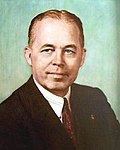Campaign
Louisiana's reformist anti-Long faction supported Sam H. Jones, who had been governor from 1940 to 1944. Jones was endorsed by outgoing Governor Davis and high-profile Louisiana politicians, such as Senator John H. Overton and Mayor deLesseps Story Morrison Sr. of New Orleans, who controlled the city's powerful Crescent City Democratic Association. Jones's reform campaign was weakened by reminders of unethical deals and heavy-handed political tactics in his previous term and by the electorate's lack of enthusiasm for reform governors after eight years.
Sam Jones's main opponent was Long, who had been governor in 1939–40 and the inheritor of his brother Huey Long's Longite political faction. Funded by politicians, oil and gas money, and contributions from organized crime in the New Orleans area, Long ran a theatrical and entertaining campaign, making stump speeches that were a mix of political harangue and humorous anecdotes. His platform called for the elimination of Jones's civil service, the doubling of state spending on programs like pensions, school lunches, charity hospitals and asylums, new trade schools, pay increases for teachers, an increased homestead tax exemption, and bonuses for veterans of World War II. Through payoffs and promises of support, Long managed to gain the backing of powerful former enemies, State Senator Dudley LeBlanc, former Governor Jimmie Noe, and U.S. Representative F. Edward Hebert.
Robert F. Kennon drew most of his support from North Louisiana and reformers disillusioned with Jones. Jimmy Morrison (no relation to Mayor Morrison) was supported by former New Orleans mayor Robert Maestri and his Old Regular political machine and finished in fourth place.
Runoff
In the runoff, the Old Regulars threw their support behind Long. With his longtime enemies were supporting Long, Mayor Morrison stepped up his campaigning for Jones and began a feud with Long that would last until Long's death in 1960.
The runoff election saw Long elected to the governor's office with an overwhelming majority. Of Louisiana's 64 parishes, only East Baton Rouge and West Feliciana went for Jones. Jones even lost his home base of Calcasieu Parish. He did not seek the governorship again.



